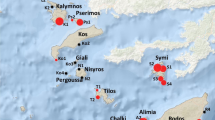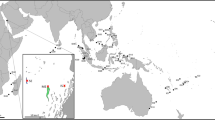Abstract
In 1983, Diadema antillarum suffered mass mortality throughout the Caribbean Sea and the western Atlantic Ocean. I followed the dynamics of populations at the San Blas Islands, Panamá from April 1983 to November 1987. Density measurements indicate that populations of D. antillarum have not recovered from the die-offs that killed nearly 97% of the individuals. There was recruitment to the 1 to 1.5 cm class immediately after the mass mortality, but there has been little additional influx of juveniles since then. The low number of observable juveniles could not be attributed to elevated rates of predation on very small individuals. Rates of recruitment did not differ between reefs with artificially increased densities of D. antillarum and reefs kept free of sea urchins; thus, the lack of recruitment did not arise from absence of adults that could provide settlement cues to the larvae or protection to newly settled juveniles. Other species of sea urchins did not show a clear pattern of increase after the demise of D. antillarum. Therefore, interspecific competition directed towards D. antillarum juveniles did not increase after the mass mortality. Two reefs where Echinometra viridis, Eucidaris tribuloides and Lytechinus williamsi, were removed showed no significant differences in recruitment of D. antillarum relative to two reefs where these species were allowed to remain at their natural densities. Resident D. antillarum after the mass mortality produced gametes with the same per capita intensity and lunar synchrony as before the mass mortality. However, it is possible that the probability of fertilization of their gametes decreased because of low population density. The most likely explanation for lack of recruitment is that the reduced numbers of reproducing adults at Panamá and upstream locations resulted in levels of larval supply that were inadequate to sustain recruitment on Panamanian reefs.
Similar content being viewed by others
Literature cited
Bak, R. P. M. (1985). Recruitment patterns and mass mortalities in the sea urchin Diadema antillarum. Proc. 5th int. coral Reef Congr. 5: 267–272. [Gabrie, C. et. al (eds.) Antenne, Museum-EPH, Moorea, French Polynesia]
Bak, R. P. M., Carpay, M. J. E., de Ruyter van Steveninck, E. D. (1984). Densities of the sea urchin Diadema antillarum before and after mass mortalities on the coral reefs of Curacao. Mar. Ecol. Prog. Ser. 17: 105–108
Bak, R. P. M., Eys, G. van (1975). Predation of the sea urchin Diadema antillarum Philippi on living coral. Oecologia 20: 111–115
Bauer, J. C. (1976). Growth, aggregation, and maturation in the echinoid Diadema antillarum. Bull. mar. Sci. 26: 273–277
Bauer, J. C. (1982). On the growth of a laboratory-reared sea urchin, Diadema antillarum (Echinodermata: Echinoidea). Bull. mar. Sci. 32: 643–645
Birkeland, C. (1982). Terrestrial runoff as a cause of outbreaks of Acanthaster planci (Echinodermata: Asteroidea). Mar. Biol. 69: 175–185
Breen, P. A., Carolsfeld, W., Yamanaka, K. L. (1985). Social behavior of juvenile red sea urchins, Strongylocentrotus franciscanus (Agassiz). J. exp. mar. Biol. Ecol. 92: 45–62
Cameron, R. A., Schroeter, S. C. (1980). Sea urchin recruitment: effect of substrate selection on juvenile distribution. Mar. Ecol. Prog. Ser. 2: 243–247
Carpenter, R. C. (1981). Grazing by Diadema antillarum (Philippi) [sic] and its effects on the benthic algal community. J. mar. Res. 39: 749–765
Carpenter, R. C. (1986). Partitioning herbivory and its effects on coral reef algal communities. Ecol. Monogr. 56: 345–363
Carpenter, R. C. (1988). Mass-mortality of a Caribbean sea urchin: immediate effects on community metabolism and other herbivores. Proc. natn. Acad. Sci. U.S.A. 85: 511–514
Ebert, T. A. (1983). Recruitment in echinoderms. In: Lawrence, J. M., Jangoux, M. (eds.) Echinoderm studies, 1. A. A. Balkema, Rotterdam, p. 169–203
Hawkins, C. M., Lewis, J. B. (1982). Ecological energetics of the tropical sea urchin Diadema antillarum Philippi in Barbados, West Indies. Estuar. cstl Shelf Sci. 15: 645–669
Hay, M. E., Taylor, P. R. (1985). Competition between herbivorous fishes and urchins on Caribbean reefs. Oecologia 65: 591–598
Highsmith, R. C. (1982). Induced settlement and metamorphosis of sand dollar (Dendraster excentricus) larvae in predator-free sites: adult sand dollar beds. Ecology 63: 329–337
Hughes, T. P., Keller, B. D., Jackson, J. B. C., Boyle, M. J. (1985). Mass mortality of the echinoid Diadema antillarum Philippi in Jamaica. Bull mar. Sci. 36: 377–384
Hughes, T. P., Reed, D. C., Boyle, M.-J. (1987). Herbivory on coral reefs: community structure following mass mortalities of sea urchins. J. exp. mar. Biol. Ecol. 113: 39–59
Hunte, W., Cote, I., Tomascic, T. (1986). On the dynamics of the mass mortality of Diadema antillarum in Barbados. Coral Reefs 4: 135–139
Hunte, W., Younglao, D. (in press). Recruitment and population recovery in the black sea urchin Diadema antillarum in Barbados. Mar. Ecol. Prog. Ser.
Iliffe, T. M., Pearse, J. S. (1982). Annual and lunar reproductive rhythms of the sea urchin Diadema antillarum (Philippi) [sic] in Bermuda. Int. J. Invertebrate Reprod. (Amsterdam) 5: 139–148
Keller, B. D. (1982). Fish predation and recruitment of echinoderms in a sea grass meadow. In: Lawrence, J. M. (ed.) Echinoderms. Proceedings of the International Conference, Tampa Bay. A. A. Balkema, Rotterdam, p. 275
Lessios, H. A. (1981). Reproductive periodicity of the echinoids Diadema and Echinometra on the two coasts of Panamá. J. exp. mar. Biol. Ecol. 50: 47–61
Lessios, H. A. (1984). Possible prezygotic reproductive isolation in sea urchins separated by the Isthmus of Panamá. Evolution 38: 1144–1148
Lessios, H. A. (1985). Annual reproductive periodicity in eight echinoid species on the Caribbean coast of Panama. In: Keegan, B. F., O'Connor, B. D. S. (eds.) Echinodermata. Proceedings of the Fifth International Echinoderm Conference. A. A. Balkema, Rotterdam, p. 303–311
Lessios, H. A., Cubit, J. D., Robertson, D. R., Shulman, M. J., Parker, M. E., Garrity, S. D., Levings, S. C. (1984a). Mass mortality of Diadema antillarum on the Caribbean coast of Panama. Coral Reefs 3: 173–182
Lessios, H. A., Robertson, D. R., Cubit, D. J. (1984b). Spread of Diadema mass mortality through the Caribbean. Science, N.Y. 226: 335–337
Levitan, D. R. (in press, a). Plant-herbivore biomass responses following the mass mortality of Diadema antillarum J. exp. mar. Biol. Ecol.
Levitan, D. R. (in press, b). Asynchronous spawning and aggregative behavior in the sea urchin Diadema antillarum (Philippi) [sic]. In: Burke, P. (ed.) Proceedings of the Sixth International Echinoderm Conference. A. A. Balkema, Rotterdam
Lewis, J. B. (1966). Growth and breeding in the tropical echinoid Diadema antillarum Philippi. Bull. mar. Sci. 16: 151–158
Liddell, W. D., Ohlhorst, S. L. (1986). Changes in benthic community composition following the mass mortality of Diadema at Jamaica. J. exp. mar. Biol. Ecol. 95: 271–278
Pearse, J. S., Hines, A. H. (1987). Long-term population dynamics of sea urchins in a central California kelp forest: rare recruitment and rapid decline. Mar. Ecol. Prog. Ser. 39: 275–283
Pennington, J. T. (1985). The ecology of fertilization of echinoid eggs: the consequences of sperm dilution, adult aggregation, and synchronous spawning. Biol. Bull. mar. biol. Lab., Woods Hole 169: 417–430
Reinthal, P. N., Kensley, B., Lewis, S. M. (1984). Dietary shifts in the queen triggerfish, Balistes vetula in the absence of its primary food item, Diadema antillarum. Pubbl. Staz. zool. Napoli (I. Mar. Ecol.) 5: 191–195
Robertson, D. R. (1987). Responses of two coral reef toadfishes (Batrachoididae) to the demise of their primary prey, the sea urchin Diadema antillarum. Copeia 1987: 637–642
Sammarco, P. W. (1980). Diadema and its relationships to coral spat mortality: grazing, competition, and biological disturbance. J. exp. mar. Biol. Ecol. 45: 245–272
Sammarco, P. W. (1982a). Echinoid grazing as a structuring force in coral communities: whole reef manipulations. J. exp. mar. Biol. Ecol. 61: 31–55
Sammarco, P. W. (1982b). Effects of grazing by Diadema antillarum Philippi (Echinodermata: Echinoidea) on algal diversity and community structure. J. exp. mar. Biol. Ecol. 65: 83–105
Sammarco, P. W., Williams, A. H. (1982). Damselfish territoriality: influence on Diadema distribution and implications for coral community structure. Mar. Ecol. Prog. Ser. 8: 53–59
Scoffin, T. P., Stearn, C. W., Boucher, D., Frydl, P., Hawkins, C. M., Hunter, I. G., MacGeachy, J. K. (1980). Calcium carbonate budget of a fringing reef on the west coast of Barbados. Part II. Erosion, sediments and internal structure. Bull. mar. Sci. 30: 475–508
Stearn, C. W., Scoffin, T. P. (1977). Carbonate budget of a fringing reef, Barbados. Proc. 3rd int. Symp. coral Reefs 2: 471–476 [Taylor, D. L. (ed.) School of Marine and Atmospheric Sciences, University of Miami]
Tegner, M. J., Dayton, P. K. (1977). Sea urchin recruitment patterns and implications of commercial fishing. Science, N.Y. 196: 324–326
Tegner, M. J., Dayton, P. K. (1981). Population structure, recruitment and mortality of two sea urchins (Strongylocentrotus franciscanus and S. purpuratus) in a kelp forest. Mar. Ecol. Prog. Ser. 5: 255–268
Williams, A. H. (1980). The threespot damselfish: a noncarnivorous keystone species. Am. Nat. 116: 138–142
Williams, A. H. (1981). An analysis of competitive interactions in a patchy back-reef environment. Ecology 62: 1107–1120
Younglao, D., Hunte, W. (In press). Spawning patterns in the black sea urchin Diadema antillarum in Barbados. J. exp. mar. Biol. Ecol.
Author information
Authors and Affiliations
Additional information
Communicated by J. M. Lawrence, Tampa
Rights and permissions
About this article
Cite this article
Lessios, H.A. Population dynamics of Diadema antillarum (Echinodermata: Echinoidea) following mass mortality in Panamá. Mar. Biol. 99, 515–526 (1988). https://doi.org/10.1007/BF00392559
Accepted:
Issue Date:
DOI: https://doi.org/10.1007/BF00392559




